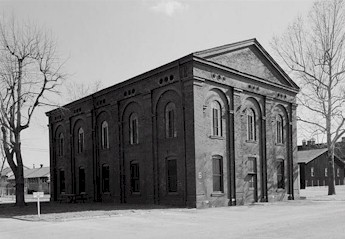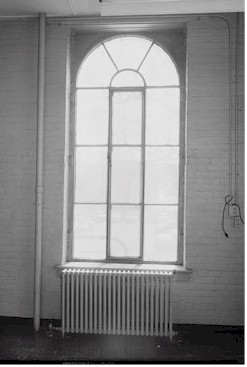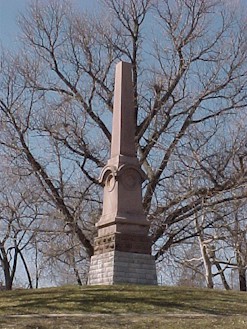Fort Belle Fontaine,
established in 1805 at the mouth of Cold Water Creek near the confluence of
the Mississippi and Missouri Rivers, provided crucial military protection for
St. Louis after the signing of the Louisiana Purchase in 1804. This remote
military fort and its small garrison greeted the first pioneers and settlers
heading west into the new frontier and served as a way station for members of
the Lewis and Clark Expedition prior to and following its historic "Voyage of
Discovery" to the Pacific Ocean.
By 1825, Fort Belle Fontaine and its small arsenal had
fallen into a sorry state of disrepair. Military commanders at the time
considered the fort to be unhealthy due to the side effects of frequent
flooding, and it was decided that a new military post and separate arsenal
facility was needed.
On July 8, 1826, troops from Fort Belle Fontaine helped
establish a new military base of operations south of St. Louis near the
village of Carondelet. This new military post was named
Jefferson Barracks in honor of President
Thomas Jefferson who had died on July, 4, 1826. A small contingent of troops
remained at Fort Belle Fontaine to protect the arsenal until the new one could
be built on a 40 acre tract of land located three miles south of St. Louis
near modern day Second and Arsenal Streets in south St. Louis.
In 1827, the first building on the new arsenal grounds was
completed but the small facility at Fort Belle Fontaine continued to provide
munitions and military supplies for troops operating in the Louisiana
Territory until June 1828. Over the next few years, Fort Belle Fontaine was
abandoned and the new St. Louis Arsenal grew to house a large three story
brick building, completed in 1828, an armory, an ammunition plant, and several
wagon repair shops.
Over the proceeding years, the St. Louis Arsenal would
directly impact the St. Louis region both militarily and economically. At the
start of the Mexican War in 1846, it was estimated that the nearly 500
civilians were employed at the facility. During the years leading up to the
Civil War, the St. Louis Arsenal continued to supply arms and ammunition to
settlers and soldiers alike.
By early 1861, the dark tide of the pending war between the
North and South settled upon Missouri and the Mississippi Valley. At the time,
the state of Missouri was considered to be a "Pro- Slave" state and its very
future was threatened to be torn asunder by Secessionist Sympathizers,
Abolitionist factions and Unionists who favored the preservation of the Union.
The St. Louis Arsenal would play a pivotal role in determining what faction
would control Missouri during the Civil War.
It was estimated that prior to the start of the Civil War,
the St. Louis Arsenal contained an estimated 60,000 muskets, over 1.5 million
rounds of ammunition, 90,000 pounds of explosive gun powder and several
cannons. As the battle lines started to be drawn, it was clear to the
leadership of the Union army that the St. Louis Arsenal would become a prime
target of attack by pro southern secessionist militia units in the event war
broke out between the states. To prevent such an attack, Union Captain
Nathaniel Lyon, a feisty military officer with strong anti-slavery beliefs and
his military unit, were assigned to St. Louis in early 1861 in an attempt to
bolster the small garrison protecting the arsenal.
"The President of the United States directs that you
enroll in the military service of the United States the legal citizens of
St. Louis and vicinity….. for the purpose of maintaining the authority of
the United States [and] for the protection of the peaceable inhabitants of
Missouri. It is revolutionary times"
General Winfield Scott to Cpt. Nathaniel Lyon April 1861
On April 12, 1861, the city of St. Louis and the
surrounding region felt the resulting impact of the first shots of the Civil
War when Confederate Forces bombarded Fort Sumter. As a result of open
hostilities between the North and South, Captain Lyon secretly transported
20,000 muskets and 100,000 rounds of ammunition by steam ship from the St.
Louis Arsenal to Alton Illinois.
On May 9, 1861, Captain Lyon had learned that Missouri
Militia troops sympathetic to the Southern cause, camped at Camp Jackson,
intended to attack the St. Louis Arsenal in order to secure the arms and
munitions stored there for the South. Captain Lyon confirmed this information
by dressing up as a woman and reconnoitering Camp Jackson himself in an open
carriage.
On the morning of May 10, 1861, Federal troops, including
units from Jefferson Barracks, the St. Louis Arsenal, and St. Louis Home
Guard, under the command of Captain Lyon, marched out of the St. Louis Arsenal
and proceeded towards Camp Jackson.
Prior to leaving the protection of the arsenal that fateful
morning, Captain Lyon had received a dispatch from D.M. Frost, the garrison
commander of Camp Jackson.
"Sir; I am constantly in receipt of information that
you contemplate an attack upon my camp; whilst I understand you are
impressed with the idea that an attack upon the arsenal and United States
troops is intended on the part of the Militia of Missouri, I am greatly at a
loss to know what could justify you in attacking citizens of the united
States, who are in lawful performance of duties devolving upon them under
the Constitution."
D.M. Frost's letter did little to dissuade Captain Lyon
from taking action against the Missouri Militia at Camp Jackson. Lyon and his
troops encircled the pro-southern militia quartered at Camp Jackson, near the
modern day site of Frost Campus on the grounds St. Louis University. This show
of Federal might convinced D.M. Frost to surrender Camp Jackson without a
fight.
The quick thinking of Captain Lyon would earn him great
favor from his military superiors and keep Missouri in the Union but the day
would not end without the blood of innocent St. Louisans being spilled on the
streets of city.
The St. Louis Arsenal continues to serve the nation as an
active military reservation even today. The Arsenal is maintained by the U.S.
Air Force and the Department of Defense Mapping Agency Aerospace Center.
In the spring of 2002, there was considerable commotion
regarding an apparition that had shown it self to several different employees
on at least two different occasions. During one of these encounters, the
specter, dubbed the "Blue Man" due to his bluish complexion, was observed by
two different government employees at the same time. Further investigation by
an employee working at the facility revealed that employees at the Arsenal
have reported encounters with the "Blue Man" for over thirty years. Accounts
of each encounter vary but for the most part, the "Blue Man" has been
described as being a white haired, stoop shouldered elderly man, wearing a
long dark blue nineteenth century military style jacket with "tails". One
employee who reported seeing the "Blue Man" while working in Building 36 on
the evening shift, stated that the elderly spirit appeared to be transparent.
To the employee's amazement, the wispy figure disappeared into the shadows
right before his yes. In another instance, an employee reported seeing the
"Blue Man" in solid form. The employee later reported that from a distance,
the ghostly visitor appeared to be a real person but that upon closer
inspection the old man seemed to simply fade away into the night.
The true identity of the "Blue Man" remains a mystery,
though his connection with the world of the living appears to be somehow
linked to the older (circa 1918) sections of Building 36. Since the founding
of the Arsenal in 1827, many older buildings have previously occupied the same
location as that of Building 36.
During World War I and World War II, Building 36 was used
by the Medical Supply Depot as a quartermaster warehouse and morgue. Though
gruesome as that sounds, it still does not explain the existence of the ghost
of a blue skinned elderly man wearing a nineteenth century military jacket.
Those "anonymous" employees who have witnessed the "Blue
Man" first hand are understandably reserved about talking about their chance
encounters with him. I have been assured by one of these anonymous sources,
that in each instance where the "Blue Man" has been observed at the Arsenal,
the employees who later reported the encounter were "Sincere" about their
brush with the elderly ghost with the "Bluish" complexion.


